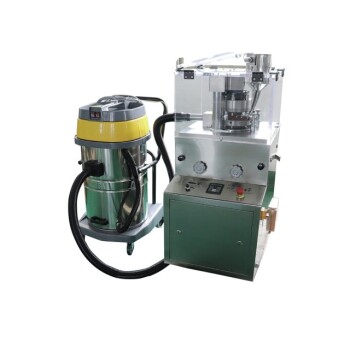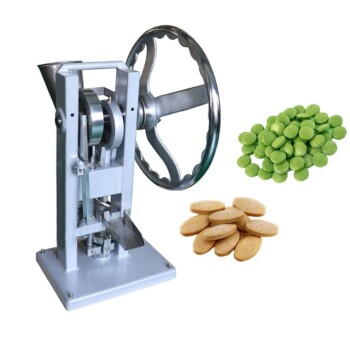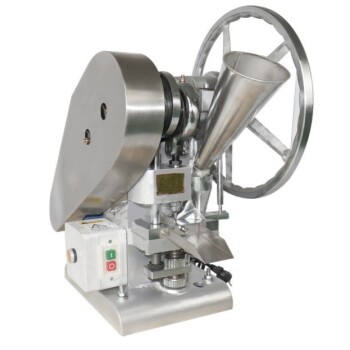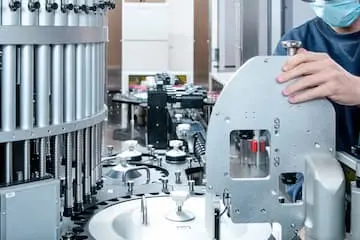Our tablet punching machines are designed for precise and efficient tablet production in industries such as pharmaceuticals, chemicals, and food. We offer a range of options including lab-scale rotary machines, single punch manual presses, and electric tablet presses. These machines are ideal for small batch production and research purposes, ensuring high-quality tablets with customizable shapes and sizes.
Toggle Categories
Get Instant Support
Choose your preferred way to connect with our team
-
Get Free Quote Fill out form for detailed pricing
-
Send Email Detailed inquiry support
-
WhatsApp Quick mobile chat
Response Time
Within 8 hours on working days, 24 hours on holidays
tablet punching machine

Lab Scale Rotary Single Punch Tablet Press Machine TDP Tablet Punching Machine
Item Number : TPM-01

Single Punch Manual Tablet Press Machine TDP Tablet Punching Machine
Item Number : TPM-02

Single Punch Electric Tablet Press Machine TDP Tablet Punching Machine
Item Number : TPM-04
Comprehensive Overview of Tablet Punching Machines
Tablet punching machines are essential for producing high-quality tablets with uniform size and shape, making them indispensable in industries like pharmaceuticals, chemicals, and food. These machines work on the principle of compression, where powder is compressed into tablets using upper and lower punches in a die. Our range of tablet punching machines includes lab-scale rotary machines, single punch manual presses, and electric tablet presses, each designed to meet specific production needs.
Key Features and Advantages
- Compact Design: Our machines are designed to be compact, ensuring easy mobility and space optimization in any workspace.
- Versatility: Capable of producing tablets of various shapes and sizes, our machines cater to diverse industrial needs.
- Durability: Constructed with heavy-duty materials, our machines are built to withstand extended use without compromising performance.
- Ease of Operation: With user-friendly interfaces and straightforward operation, our machines require minimal training to operate effectively.
- Customization: We offer customizable solutions to tailor the machines to your specific production requirements.
Applications and Industries
Our tablet punching machines are widely used in:
- Pharmaceuticals: For producing medication tablets with precise dosages.
- Chemicals: In the production of industrial pellets and chemical tablets.
- Food Industry: For creating food supplements and confectionery items.
- Research Laboratories: Ideal for small batch production and experimentation.
Why Choose Our Tablet Punching Machines?
- Professional Expertise: With years of experience in the industry, we provide expert guidance and support to ensure you get the right machine for your needs.
- Customizable Solutions: We understand that each industry has unique requirements. Our machines can be customized to meet specific production needs.
- Quality Assurance: Our machines undergo rigorous quality checks to ensure they meet the highest standards of performance and durability.
- Comprehensive Support: From installation to maintenance, we offer comprehensive support to ensure your machine operates efficiently.
Get in Touch
For more information or to discuss your specific needs, please contact us. Our team of experts is ready to assist you in finding the perfect tablet punching machine for your business.
Conclusion
Investing in our high-quality tablet punching machines ensures efficient and precise tablet production, meeting the demands of various industries. With our commitment to quality, customization, and customer support, you can trust us to deliver solutions that enhance your production capabilities.
Contact us today to learn more and take the first step towards improving your tablet production process.
FAQ
What Is A Tablet Punching Machine?
What Are The Main Types Of Tablet Punching Machines?
What Is The Principle Of A Tablet Punching Machine?
What Are The Applications Of Tablet Punching Machines?
What Are The Advantages Of Using A Tablet Punching Machine?
How Does A Manual Tablet Press Work?
What Industries Benefit From Using Tablet Punching Machines?
What Safety Features Are Included In Tablet Punching Machines?
Why Has The Tablet Press Evolved Over Time?
REQUEST A QUOTE
Our professional team will reply to you within one business day. Please feel free to contact us!
Related Articles

How to use PTFE to improve the working efficiency of pumps and valves
Polytetrafluoroethylene (PTFE) has become a key material for improving the efficiency of pumps and valves due to its unique physical and chemical properties.

X-Ray Fluorescence Spectrometer: Powder Compression Method for Sample Preparation
This article discusses the powder compression method in XRF spectral analysis, focusing on sample preparation techniques and equipment.

Application of Hot Isostatic Pressing Technology in Special Ceramic Preparation
Explores the use of HIP technology in special ceramics, focusing on preparation, characteristics, and industry trends.

Laboratory Sample Preparation and Digestion Equipment
Overview of essential lab equipment for sample preparation and digestion.

Sample Preparation Methods in X-ray Fluorescence and Their Impact on Test Results
Explores the tablet and melting methods in X-ray fluorescence, detailing their advantages, disadvantages, and key considerations.

X-ray Fluorescence Spectrometry: Powder Tableting Sample Preparation
A comprehensive guide on the powder tableting method for sample preparation in X-ray fluorescence spectrometry, detailing grinding, pressing, and application scope.

IR (Tablet Pressing Method) Operation
Detailed guide on the IR tablet pressing method, including instruments, reagents, sample preparation, and testing procedures.

Issues with Poor Demoulding in Manual Tablet Presses
Analyzes the causes of poor demoulding in manual tablet presses, focusing on powder, mold, machine body, and operator factors.

X-ray Fluorescence Spectrometry Analysis Method | Sample preparation method: tableting sample preparation
Detailed guide on XRF analysis, focusing on sample preparation and powder sample methods.

Hydraulic Tablet Press: Comprehensive Guide to Design, Operation, and Applications
Explore the advanced features, operational principles, and diverse applications of hydraulic tablet presses in various industries. Learn how these machines ensure high-quality tablet production with detailed insights.

Innovative tableting solutions: a comprehensive analysis of laboratory single punch tablet presses
Discover the working principle of lab single punch tablet press and its advantages. Learn how it operates and its role in research and development. Find out the differences between single punch and rotary tablet presses.

Understanding Cold Isostatic Pressing (CIP) and Hot Isostatic Pressing (HIP) in Powder Metallurgy
Cold Isostatic Pressing (CIP) and Hot Isostatic Pressing (HIP) are two powder metallurgy techniques used to produce dense and high-quality metal components.

Exploring the Applications of Isostatic Pressing
Isostatic pressing is a powder metallurgy technique that applies equal pressure from all directions to a compacted powder. There are two types of isostatic pressing: cold isostatic pressing (CIP) and hot isostatic pressing (HIP). CIP uses pressure at room temperature, while HIP applies heat and pressure to the powder.

Fully automatic tablet press operating steps and replacement accessories
Relevant introduction to the operating steps and replacement accessories of the fully automatic tablet press

Operating steps and precautions for electric isostatic press
Relevant introduction to the operating steps and precautions of the electric isostatic press.

Operating steps and precautions for electric tablet press
Relevant introduction to the operating steps and precautions of electric tablet press.

Manual mechanical press operating steps
Introduction to the operating steps of manual mechanical press.

Manual tablet press operating steps and precautions
Details on the operation of manual tablet presses, replacement of rubber rings, and steps for replacement of parts.

Is a High-Priced Rotavapor Worth the Investment
Rotary evaporators, also known as rotavaps, are essential laboratory equipment used in the chemical, pharmaceutical, and biotech industries for the separation of solvents from a solution.

Understanding the Dry Bag Cold Isostatic Press Machine by KinTek
Powder metallurgy is a manufacturing route that allows for the production of specific materials, especially for high-performance applications. It reduces material waste and produces parts that are close to the final shape. KinTek's CIP equipment has been successfully used to consolidate most common metals, and there is a growing interest in using it for metal powder processing in a wider range of applications.
